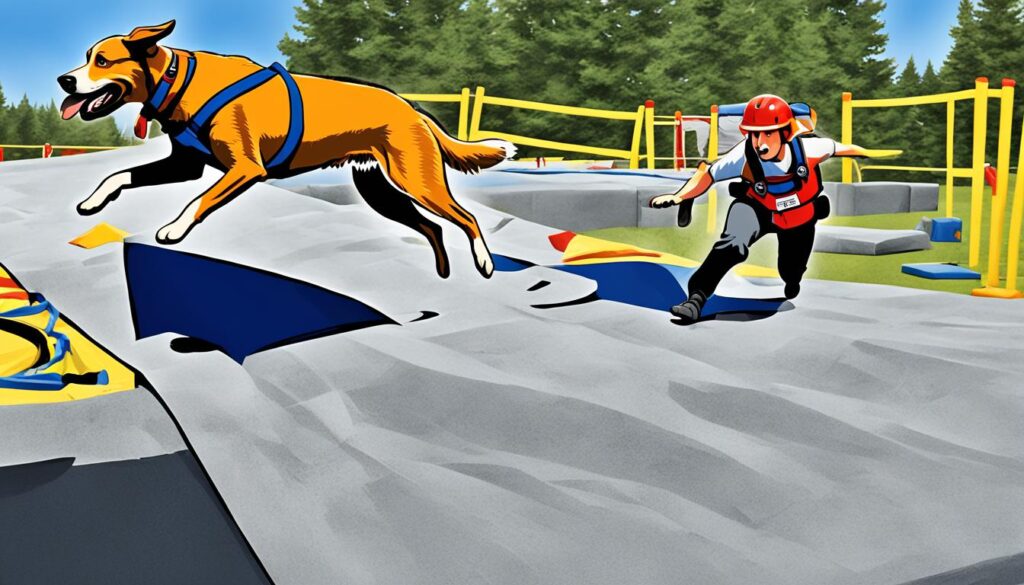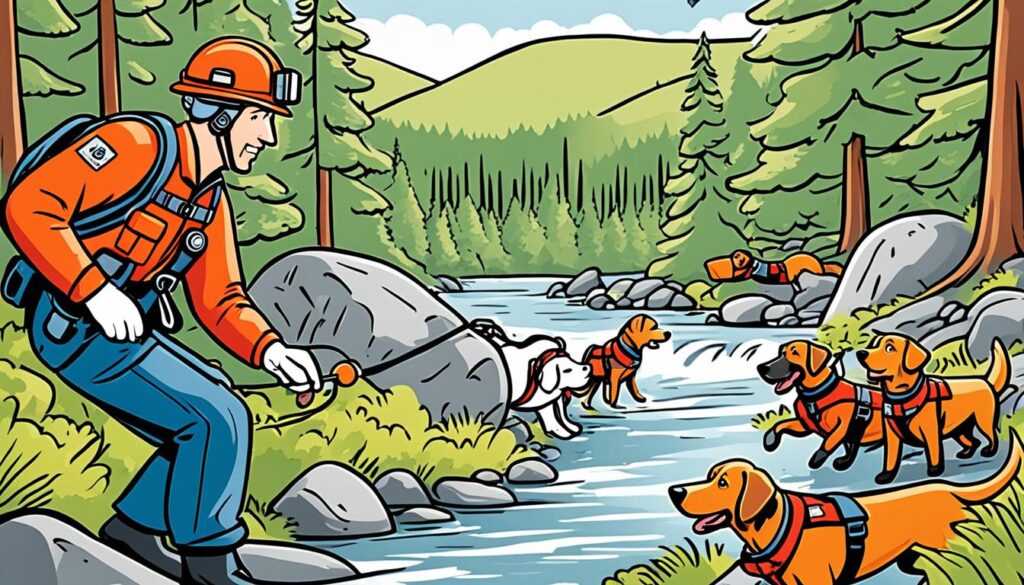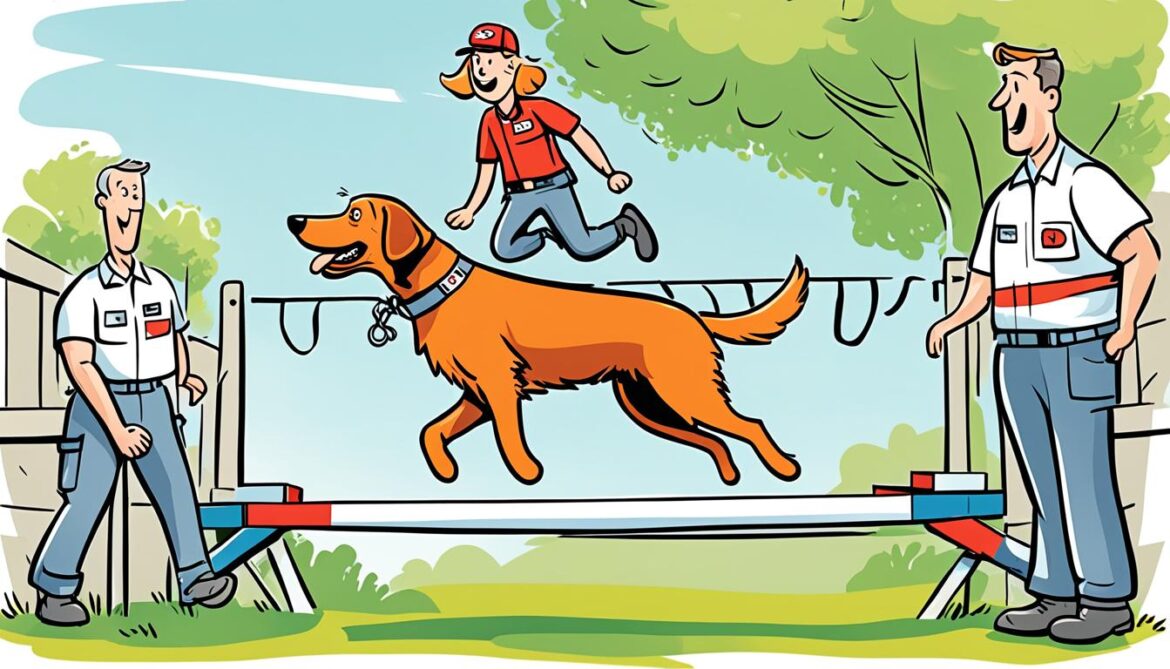Imagine the heart-stopping moment when disaster strikes and lives hang in the balance. In those crucial seconds, every second counts. That’s where search and rescue dogs come in – these fearless, four-legged heroes are trained to find and save people in the most challenging situations.
Whether it’s a natural disaster or a missing person, their instincts and rigorous training can mean the difference between life and death. But how does one train a search and rescue dog? How can you prepare your loyal companion to become a true lifeline in times of crisis?
In this comprehensive guide, we will take you on a journey through the world of search and rescue dog training, uncovering the essential techniques, expert tips, and professional programs that will transform your canine into an invaluable asset. So, grab a leash and prepare to embark on a life-saving adventure with your furry partner!
Key Takeaways
- Search and rescue dogs are trained to save lives in emergency situations.
- Proper training is crucial for developing highly skilled search and rescue canines.
- There are professional training programs available for search and rescue dogs.
- It’s important to choose the right training program for your dog’s specific needs.
- Advanced techniques can further enhance your dog’s search and rescue abilities.
Understanding the Importance of Search and Rescue Dog Training
Before diving into the training process, it’s crucial to understand the significance of search and rescue dog training. Search and rescue dogs are highly trained canines that play a vital role in emergency situations, assisting in locating missing people, tracking scents, and providing essential support to rescue teams. Their training is essential for their effectiveness and safety in these high-pressure situations. Training for search and rescue dogs goes beyond basic obedience, encompassing specialized skills and behaviors necessary for their life-saving missions.
The Role of Search and Rescue Dogs in Emergency Situations
Search and rescue dogs are trained to navigate difficult terrains, detect scents, and locate individuals in a variety of circumstances such as natural disasters, wilderness incidents, and urban emergencies. They possess a remarkable ability to detect human scent, even in challenging conditions, making them invaluable assets to search and rescue operations.
These highly trained canines can cover large areas quickly, often outperforming human search teams in terms of speed and accuracy. Their acute sense of smell, honed through meticulous training, allows them to locate individuals who may not be easily visible or accessible to human rescuers.
Search and rescue dogs provide an efficient and effective means of locating missing persons, reducing response time, and increasing the likelihood of successful rescues.
The Impact of Training on Search and Rescue Dogs
Training plays a crucial role in shaping search and rescue dogs into reliable and responsive partners during rescue missions. It helps to refine their natural abilities, enhance their response to commands, and improve their decision-making skills in challenging situations.
Through training, search and rescue dogs develop the ability to recognize and respond appropriately to specific scents, such as those emitted by humans in distress. This capability enables them to distinguish between search targets, filter out distractions, and focus on locating the missing individuals accurately.
Additionally, training enhances their physical endurance, agility, and confidence, enabling them to traverse treacherous terrains, navigate obstacles, and remain calm under stressful circumstances. These qualities are essential for their safety and effectiveness while aiding in rescue operations.
Essential Training Techniques for Search and Rescue Dogs
When it comes to search and rescue canine training, mastering the essential techniques is crucial. These techniques form the foundation for developing a highly skilled search and rescue dog that can effectively navigate various challenging scenarios. From obedience training to scent detection exercises, each technique plays a vital role in preparing your canine companion for life-saving missions.
Obedience Training
Before diving into specialized search and rescue training, it’s essential to establish a strong foundation of obedience. Teaching your dog basic commands such as sit, stay, and come not only ensures their safety but also enhances their ability to follow directions during rescue operations. Consistency, positive reinforcement, and reward-based training methods are key to fostering good behavior and responsiveness to commands.
Scent Detection Training
Scent detection is one of the most critical skills for search and rescue dogs. By training your dog to identify and track specific scents, they can effectively locate missing persons or detect hazardous substances in emergency situations. The training process involves introducing target scents, such as human scent or a specific substance, and gradually increasing the difficulty of scent discrimination exercises.
Agility Training
Search and rescue missions often involve navigating challenging terrain and obstacles. Agility training helps dogs develop the physical strength, coordination, and flexibility required to overcome these obstacles quickly and efficiently. Through exercises such as jumps, tunnels, and balance beams, dogs learn to maneuver through various environments with ease.
Water Rescue Training
In many search and rescue scenarios, bodies of water can pose significant challenges. Water rescue training equips dogs with the skills to navigate water bodies, locate individuals in distress, and perform water-based rescues. This specialized training includes swimming techniques, retrieving objects from the water, and working from boats or other flotation devices.
| Training Technique | Description |
|---|---|
| Obedience Training | Establish a foundation of basic commands, ensuring your dog’s safety and responsiveness during rescue operations. |
| Scent Detection Training | Teach your dog to identify and track specific scents to locate missing persons or detect hazardous substances. |
| Agility Training | Develop your dog’s physical strength, coordination, and flexibility to navigate challenging terrain and obstacles. |
| Water Rescue Training | Equip your dog with the skills to navigate water bodies, locate individuals in distress, and perform water-based rescues. |
By implementing these essential training techniques, you can ensure your search and rescue dog is well-prepared to handle the demands of life-saving missions. Remember, patience, consistency, and positive reinforcement are crucial throughout the training process. With dedication and the right techniques, your canine partner will become an invaluable asset in search and rescue operations.

Professional Search and Rescue Dog Training Programs
If you’re serious about preparing your canine for search and rescue missions, enrolling in a professional training program is essential. These programs provide a structured and comprehensive approach to developing the skills and abilities required for this specialized field.
Reputable search and rescue dog training programs offer a range of benefits, including:
- Expert Guidance: Highly skilled trainers with extensive experience in search and rescue dog training will guide you through the process.
- Specialized Curriculum: These programs are specifically designed to address the unique challenges and requirements of search and rescue work.
- Realistic Simulations: Training programs often include simulations of real-life search and rescue scenarios to ensure dogs are prepared for actual missions.
- Certification Options: Many professional programs offer certification upon successful completion, providing recognition of your dog’s abilities and improving their credibility in the field.
- Networking Opportunities: Training programs provide a platform to connect with fellow search and rescue dog handlers, sharing knowledge and experiences.
When choosing a search and rescue dog training program, consider the following factors:
- Accreditation: Look for programs that are accredited by reputable organizations in the field of search and rescue dog training.
- Instructors: Research the qualifications and experience of the instructors leading the program to ensure they have the necessary expertise.
- Curriculum: Evaluate the program’s curriculum to ensure it covers all essential aspects, including obedience, scent detection, tracking, and agility training.
- Facilities: Visit the training facility if possible to assess the quality of amenities and equipment available.
By investing in a professional search and rescue dog training program, you can ensure your canine partner receives the highest level of training and preparation, increasing their effectiveness in life-saving missions.

Finding Search and Rescue Dog Training Near You
If you’re looking for search and rescue dog training options near your location, you’re in the right place. Finding the right training facility and program for your canine companion is crucial to their success in life-saving missions. Here are some tips to help you in your search:
- Research local training facilities: Start by searching online or asking for recommendations from other pet owners or local authorities. Look for facilities that specialize in search and rescue dog training and have experienced trainers.
- Evaluate trainers: Once you have a list of potential facilities, take the time to evaluate the trainers. Look for certifications, experience in search and rescue training, and their ability to build a strong bond with dogs.
- Visit the training facility: Before making a decision, visit the training facility in person. Observe the training sessions and ask questions about their training methods, curriculum, and success rate.
- Consider your dog’s needs: Each dog is unique, so consider your dog’s temperament, energy level, and any specific training requirements. Choose a training program that can cater to your dog’s needs.
- Ask for references: Don’t hesitate to ask for references from other clients who have gone through the training program. Hearing about their experiences can give you valuable insights into the program’s effectiveness.
By following these tips, you can find a search and rescue dog training program near you that will provide your canine companion with the necessary skills and training for life-saving missions.
| Training Facility | Location | Programs Offered | Website |
|---|---|---|---|
| Canine Rescue Training Center | Los Angeles, CA | Obedience Training, Scent Detection, Water Rescue | www.caninerescuetraining.com |
| Search & Rescue Dog Academy | New York, NY | Agility Training, Tracking, Wilderness Survival | www.sardogacademy.com |
| K-9 Heroes Training Center | Denver, CO | Advanced Search Techniques, Urban Disaster Response | www.k9heroestraining.com |
Here are a few search and rescue dog training facilities located across the United States:
“Having a well-trained search and rescue dog is crucial in emergency situations. Finding a reputable training facility near you ensures your dog receives the proper training and preparation for life-saving missions.” – Sarah Thompson, Search and Rescue Dog Trainer
Advanced Search and Rescue Dog Training Techniques
Once your dog has mastered the foundational training, it’s time to explore advanced techniques to enhance their search and rescue abilities. In this section, we will cover advanced training methods, such as agility training, water rescue training, and more.
Agility training is a crucial component of advanced search and rescue dog training. It helps improve your dog’s speed, agility, and flexibility, allowing them to navigate obstacles with ease. Through agility training, your dog will develop the physical skills necessary to maneuver through challenging terrains while on a mission.
Water rescue training is another vital skill for search and rescue dogs. This training prepares your canine companion to perform rescues in water environments, such as rivers, lakes, and even oceans. They will learn how to swim efficiently, retrieve objects in the water, and assist individuals in distress.
In addition to agility training and water rescue training, there are several other advanced techniques that can further enhance your dog’s search and rescue abilities:
- Scent discrimination exercises to improve their ability to detect specific scents in complex environments.
- Nighttime training to acclimate your dog to working in low-light conditions.
- Tracking exercises to enhance their ability to follow scent trails and locate missing persons.
- Building searches to teach your dog how to search buildings and navigate through different rooms and levels.
- Rope and harness training to prepare your dog for vertical or elevated searches and rescues.
Continuous Training and Adaptability
It’s important to note that advanced search and rescue dog training requires ongoing commitment and continuous training. The more you expose your dog to different environments, scenarios, and challenges, the better prepared they will be to handle real-life search and rescue missions. Keep in mind that every dog is unique, and their training should be tailored to their individual strengths and weaknesses.
Remember, advanced search and rescue dog training is a journey that requires patience, dedication, and a partnership between you and your furry companion.
By consistently reinforcing their training and exposing them to new experiences, you will continue to develop their skills and enhance their search and rescue capabilities.
Now that you have a better understanding of advanced search and rescue dog training techniques, let’s move on to the next section, where we will discuss how to find search and rescue dog training near you.
| Advanced Search and Rescue Dog Training Techniques | Description |
|---|---|
| Agility training | Improves speed, agility, and flexibility. Helps dogs navigate obstacles during missions. |
| Water rescue training | Prepares dogs for rescues in water environments. Develops swimming and retrieval skills. |
| Scent discrimination exercises | Enhances ability to detect specific scents in complex environments. |
| Nighttime training | Acclimates dogs to working in low-light conditions. |
| Tracking exercises | Improves ability to follow scent trails and locate missing persons. |
| Building searches | Teaches dogs to search buildings and navigate different rooms and levels. |
| Rope and harness training | Prepares dogs for vertical or elevated searches and rescues. |
Conclusion
In conclusion, search and rescue dog training is an essential part of preparing canines for life-saving missions. These remarkable animals become invaluable assets in emergency situations through proper training. By following the expert tips and programs provided in this guide, you can ensure that your search and rescue dog is well-prepared and ready to assist when needed.
Training search and rescue dogs requires dedication, patience, and a deep understanding of their unique capabilities. By starting with the basics and gradually progressing to advanced techniques, you can develop a highly skilled and reliable search and rescue canine. Remember, consistency and positive reinforcement are key factors in shaping their behavior and performance.
As you embark on this training journey, it’s crucial to seek professional guidance and consider enrolling in reputable search and rescue dog training programs. These programs offer specialized instruction, certifications, and valuable resources to help you and your furry companion excel. Additionally, finding a training facility near you and connecting with experienced trainers can provide further support and guidance throughout the training process.
By investing time and effort into training your search and rescue dog, you are not only enhancing their abilities but also contributing to the safety and well-being of your community. These brave canines play a vital role in locating missing persons, providing assistance during natural disasters, and aiding in various emergency situations. With your dedication and their innate skills, you can make a significant difference in saving lives.
